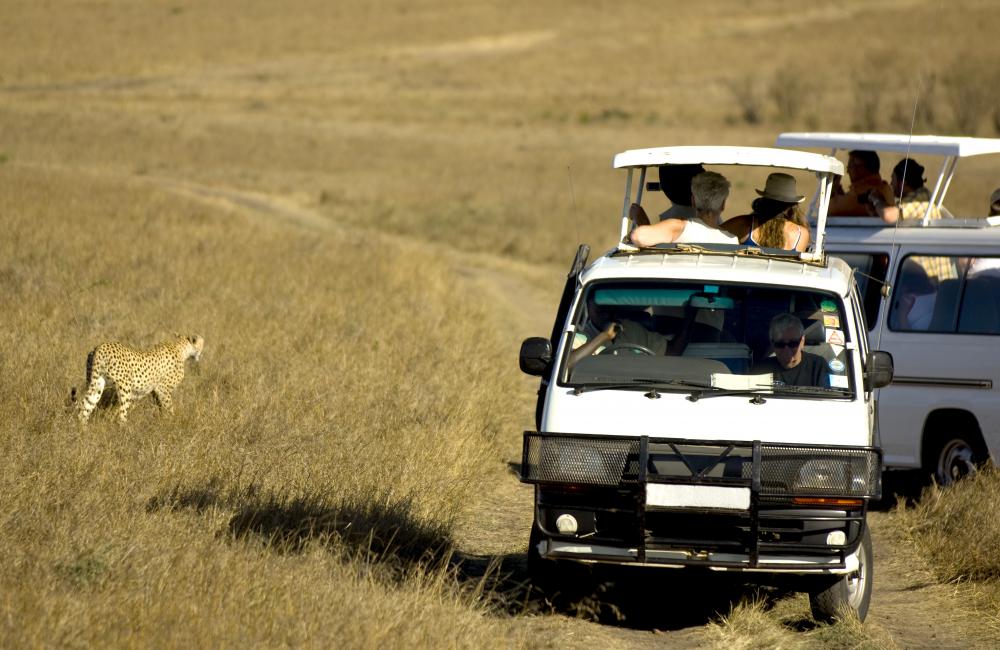At AllThingsNature, we're committed to delivering accurate, trustworthy information. Our expert-authored content is rigorously fact-checked and sourced from credible authorities. Discover how we uphold the highest standards in providing you with reliable knowledge.
What Is in a Zebra's Habitat?
The qualities of a zebra's habitat vary by species of zebra. There are three species of zebra: Grevy's, Mountain, and Burchell's (also known as Plains). The Grevy's zebra lives in a habitat including grasslands and savannas. Mountain zebras live on slopes and plateaus of mountains, as the name states. Burchell's or Plains zebras inhabit savannas, short grasslands, tall grasslands and open woodlands.
Grevy's zebras are larger than plains zebras. They have more narrow black stripes, big round ears and a white belly. Mostly located in Northern Kenya and southern to southeaster Ethiopia, this species of zebra inhabits savannas and grasslands.

Plains zebras coat can vary in number and size of stripes and the mane is short, erect hair with a tuft on the tail. Northern Kenya is the most common location for Plains zebras. The Plains zebra's habitat consists of the savannas, short grasslands, tall grasslands and open woodlands.
Grass in the tall grasslands can reach a height of 5 feet (1.5 m) tall and typically get 30 inches (76.2 cm) of rain a year. Unlike the tall grasslands, short grasslands have short grass with only approximately 10 inches (25.4 cm) of rain a year, which typically halts growth. As a combination of both, mixed grasslands grow around 2-3 feet (0.6-0.9 m) and get close to 15-25 inches (38.1-63.5 cm) of rain in a year.

The savannas are also common habitats for Grevy's and Plains zebras. Grass covers the majority of the area while trees are widely spaced out. Tree cover is only 5% to 30% of the area. Rain is plentiful enough to grow grass but not forests. Periods of drought are present, causing occasional fires to breakout and spread.
Open woodland is the only type of zebra's habitat that the Grevy's and Plains do not share. This is open forest land with a low density of trees. Plenty of sunlight shines through, but there is hardly any shade. Grass, shrubs and herbaceous plants are plentiful.
Mountain zebras are different because they have a dewlap, or flap of skin, on the throat. Wide stripes cover the rump area. Wambia and Western and Southern South Africa are the most common areas that Mountain zebras can be found. Just as the name states, Mountain zebra's habitat is on the slopes and plateaus in mountainous areas. Different locations on the mountain provide shade, temperature changes and precipitation. As the Mountain zebra moves higher the temperature drops and winds blow harder. Lakes, streams and rivers provide the surrounding animals with water. Depending on the Altitudinal Vegetation Zone, plants an grow to feed the Mountain zebra. As the altitude gets higher the plants become smaller and there is a lower rate of growth for the animals. Due to the altitude change there is a lower amount of animals which means less competition for food.
Frequently Asked Questions
What type of environment do zebras typically inhabit?
Zebras are commonly found in a variety of grassland habitats, ranging from savannas to mountainous areas. They thrive in environments with ample water sources and prefer open, grassy plains and woodlands where they can easily spot predators. Their habitat must support their grazing needs, as they primarily feed on grasses.
How does the zebra's habitat influence its social behavior?
The open grasslands and savannas where zebras live promote their social structure, which is based on large herds for protection against predators. Visibility in these habitats allows zebras to maintain visual contact with herd members, facilitating their complex social interactions and enabling them to quickly gather in defensive formations when threatened.
What are the main threats to a zebra's habitat?
Zebras face habitat loss due to human activities such as agriculture, settlement expansion, and deforestation. Climate change also poses a significant threat by altering rainfall patterns and grassland ecosystems. According to the International Union for Conservation of Nature (IUCN), habitat fragmentation and competition with livestock are additional pressures that impact zebra populations.
Do zebras migrate, and if so, how does this relate to their habitat?
Some zebra species, like the plains zebra, partake in great migrations in response to the seasonal availability of food and water in their habitats. These migrations are among the most spectacular in the animal kingdom, with herds traveling hundreds of miles across Africa's landscapes to find suitable grazing areas and water sources.
How do zebras adapt to their habitat?
Zebras have evolved several adaptations to thrive in their habitat. Their striped coat provides camouflage in the tall grasses, confusing predators during chases. They have strong, hoofed feet for traversing long distances across various terrains. Additionally, their digestive systems are well-suited to processing the coarse, fibrous grasses that dominate their grassland homes.
Can zebras survive outside of their natural habitat?
While zebras can adapt to a range of environments, their survival outside their natural habitat is challenging. They require specific grassland ecosystems to provide adequate food and water. In captivity, such as in zoos, they can survive with careful management, but they are generally less adaptable to changes than some other species when removed from their native settings.
AS FEATURED ON:
AS FEATURED ON:












Discuss this Article
Post your comments